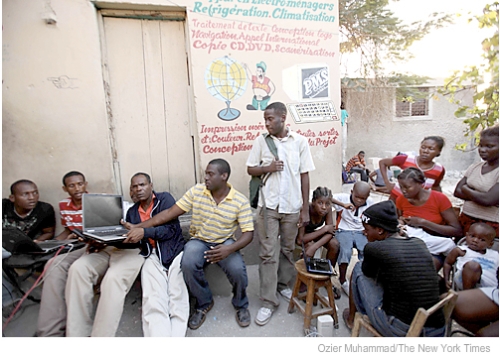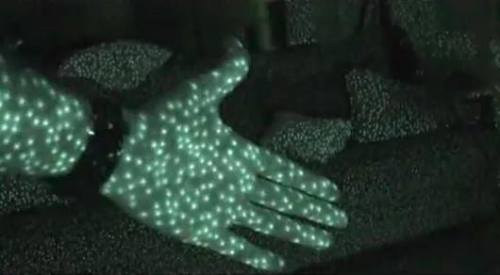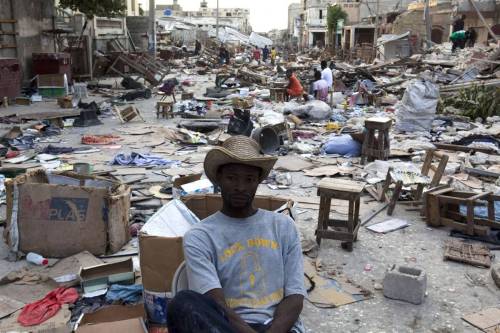The folks over at Engadget posted this pretty cool video of the new XBOX 360 Kinect seen through night vision goggles. Read the full article over at Engadgets site here
Posted in technology, Video | Leave a Comment »
&w=600 will make your youtube videos 600 pixels wide. For more info on posting YouTube videos to WordPress click here
Additional Options
&w=... or &w=...&h=...to the shortcode. It will automatically adapt to your theme’s content length and give you preferred dimensions.- You can obtain a HD (high definition) version of the video–if it has one–by appending
&hd=1 - You can disable related videos by appending
&rel=0 - You can turn on the search box by appending
&showsearch=1
Posted in Blogs | Leave a Comment »

A few days after my previous post on Haiti we had a great discussion on a call for a new type of photojournalism. The discussion stemmed from Michael David Murphys article from Photo8. I took part in a online discussion with a few dozen other photographers from around the world and we had a nice debate on what such a monumental call to action actually might bring about. It’s my belief that many of the photographers are stuck having to provide the images that the editors demand and in that sense are some what limited on what they can spend the majority of their time documenting. Its as simple as following the bosses orders first and being a photojournalist second. I’m sure that there are the exceptions, like if James Nachtway covers Haiti I’m pretty sure he can do whatever the hell he wants. So does that mean that the rest of the photographers have to descend and photograph a scene in some sort of angry mob, me against my peers style? Or is it something as simple as a strength in numbers strategy in a area thats already known for it’s instability? I’m not proposing that either in such a horrific circumstance is what goes through a photojournalists mind I’m simply asking, is this the best we can do?
In our class discussion I showed a few alternative ways that the crisis in Haiti had been photographed, one by the New York Times and one by CNN. I think these two examples show the contrast in how the crisis has been covered. One a quick drive by documentation and the other a more personal photo story that concentrates on the people surviving and living after such a tragic event. More importantly I’m interested in how technology can be used to tell more of the story than a simple cover photo and headline can. It’s an interesting time we live in and I think its amazing to see how the information that so many have access to can reform such an established mechanical tool like photographs
NYT: Devastation and Survival Along Avenue Poupelard
CNN: Haiti: 360°
* And a new one I just found on NYT: Scenes From a Ruined Boulevard
Posted in article, Photography, technology | 3 Comments »

In this documentary, the founders of Adobe Photoshop – John Knoll, Thomas Knoll, Russell Brown, and Steve Guttman – tell the story of how an amazing coincidence of circumstances, that came together at just the right time 20 years ago, spawned a cultural paradigm shift unparalleled in our lifetime.
Posted in Photography, technology, Video | 1 Comment »
Left, Bin Laden in 1998; middle, the FBI image; right, Gaspar Llamazares
This week, the FBI released a “digitally-altered” image showing what Osama Bin Laden possibly looks like now that he’s older.
While the FBI claims to have used “cutting-edge” technology to create the image, a Spanish politician has noticed that the poster is a modified version of his campaign photo — he now finds his face in America’s most wanted list.
While on the surface it’s an amusing misstep by intelligence agencies, Gaspar Llamazares, the former leader of Spain’s United Left coalition, calls the move “shameless.” His safety is at risk, hetold the BBC, and he no longer feels able to travel to America now that his likeness is on a wanted poster: “Bin Laden’s safety is not threatened by this but mine certainly is,” Llamazares said.
For the full article and the FBI’s press release click here
Posted in article, technology | Leave a Comment »
Michael David Murphy looks at Haiti coverage and asks whether photojournalists would be telling different and deeper stories if organizations would pool their resources.
For the full article click here
For more on Foto8 click here
Posted in Blogs, Photography | 3 Comments »
Yesterday Michael David Murphy (Program Manager for Atlanta Celebrates Photography) got a screen shot from his iPhone published on the New York Times website! Congrats to MDM, I’ve never met anyone that had a screenshot from a phone published.
A few of my students asked how the NYT came across his screen shot. The answer is simple from his Blog. “How did they know about his blog?” It’s simple he’s a blogging ninja. The more you blog the more likely you are to have someone stumble across your blog. So to my students keep blogging about your work and all the other interesting aspects of art and photography. Who knows you too might get published in the New York Times
Posted in Blogger, Blogs, News, Photography | Leave a Comment »
Haiti’s known as one of the poorest nations in the world and on Tuesday things got a whole lot worse for everyone who works or lives on the island nation. Communication has been severely hampered by the 7.0 earthquake however some images are starting to trickle out. These images show how massive the destruction is to Haitis infrastructure and way of life. Below are links to some of the big news agencies slideshows. WARNING the images are graphic and a severe downer.
Posted in News, Photography | 2 Comments »
A good friend of mine often gets random phone calls from me asking how to do rather basic cooking. In an attempt to “get my learn on” in the kitchen he’s started a YouTube channel called “Cooking for Dave”. The first video is on making pizza dough and for a guy that knows absolutely nothing about video editing I think he did a great job. Check out the video here
Posted in Video | Leave a Comment »
MSNBC has put together a great slideshow of top notch images from the last decade, some graphic, some cute and some simply hilarious. Click the link to see them in all there glory.
Posted in Photography | 1 Comment »






